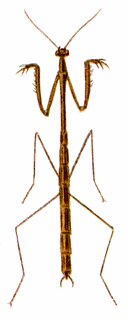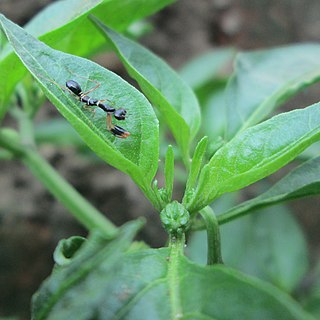Related Research Articles

Choeradodis is a genus of praying mantises with common names such as shield mantis, hood mantis, and leaf mantis because of their extended, leaf-like thoraces. The distinguishing characteristic of Choreododis from which it takes its common names is a laterally expanded thorax. This adaptation for the purpose of camouflage, as well as a rounded wing case and a habit of staying relatively flattened, aid its leaf mimicry.

Brunneria borealis, common name Brunner's mantis, Brunner's stick mantis, or northern grass mantis, is a species of praying mantis native to the southern United States. It is the only mantis species known to reproduce solely through parthenogenesis; there are no males.

Thesprotia graminis, common name American grass mantis or grass-like mantis, is a species of praying mantis native to the Southern United States. It is found in Florida and Georgia. This species can reproduce parthenogenetically or through sexual reproduction. T. graminis is similar in appearance to Brunneria borealis.

Sphodromantis viridis is a species of praying mantis that is kept worldwide as a pet. Its common names include African mantis, giant African mantis, and bush mantis.

Dead leaf mantis is a common name given to various species of praying mantis that mimic dead leaves. It is most often used in reference to species within genus Deroplatys because of their popularity as exotic pets. Examples include D. desiccata, D. lobata, and D. philippinica. Other species to which the term may apply include Acanthops falcataria, A. falcata, and Phyllocrania paradoxa.

Odontomantis planiceps, also known as Asian ant mantis, is a common species of praying mantis.

African mantis and African praying mantis are common names for many species of praying mantis native to Africa.
Oxyothespis dumonti, common name North African grass mantis, is a species of praying mantis in the family Toxoderidae. It is found in Africa.
Sphodromantis belachowski, common name African mantis or African praying mantis, is a species of praying mantis from Africa.

Sphodromantis gastrica, with the common names African mantis or common green mantis, is a species of praying mantis from Africa.
Sphodromantis centralis, common name African mantis or Central African mantis, is a species of praying mantis from Africa.
Thesprotia caribea, common name Caribbean grass mantis, is a species of praying mantis found in Antigua and Jamaica.
Thesprotia filum, common name grass mantis, is a species of praying mantis found in French Guiana, Surinam, and Trinidad.
Thesprotia insolita, common name Costa Rican grass mantis, is a species of praying mantis found in Costa Rica.
Thesprotia simplex, common name grass mantis, is a species of praying mantis found in Brazil.
Boxer mantis is a common name given to various species of praying mantis. The name comes from the way these mantises move their oversized grasping forelimbs as they communicate with each other.

Bark mantis is a common name given to various species of praying mantis, especially those with cryptic camouflage resembling tree bark. Examples include:
Ground mantis is a common name given to various species of praying mantis believed to hunt on or near ground level rather than high amid foliage.

Mantises are an order (Mantodea) of insects that contains over 2,400 species in about 430 genera in 30 families. The largest family is the Mantidae ("mantids"). Mantises are distributed worldwide in temperate and tropical habitats. They have triangular heads with bulging eyes supported on flexible necks. Their elongated bodies may or may not have wings, but all Mantodea have forelegs that are greatly enlarged and adapted for catching and gripping prey; their upright posture, while remaining stationary with forearms folded, has led to the common name praying mantis.
References
- ↑ Praying Mantises, AKA Mantids (Order Dictyoptera) Archived 2008-07-21 at the Wayback Machine
- ↑ USA Mantis
- ↑ "Odontomantis planiceps - grass mantis". Archived from the original on 2008-11-01. Retrieved 2008-07-22.
| | This Mantodea-related article is a stub. You can help Wikipedia by expanding it. |